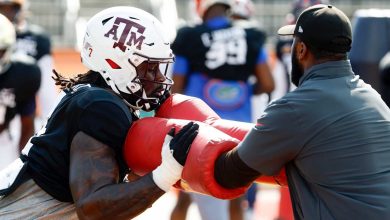If Wisconsin coach Greg Gard had his way, teams in Big Ten final wouldn’t play NCAA tournament games until Friday

Wisconsin coach Greg Gard has long been a prominent figure in the Big Ten Conference, guiding the Badgers through some of the most competitive seasons in the conference’s rich history. Known for his strategic mind and player-first approach, Gard has proven himself to be an effective leader for Wisconsin basketball. However, recently, Gard made headlines with a bold suggestion regarding the scheduling of the NCAA tournament, particularly concerning the teams coming off a deep run in their respective conference tournaments.
Gard’s proposal: if he had his way, teams playing in the Big Ten Tournament final would not have to play their NCAA tournament game until Friday, giving them more time to recover from the physically demanding tournament. This seemingly simple request holds significant implications for both the tournament scheduling and the health and well-being of student-athletes. While this suggestion has drawn attention for its practical consideration of the players’ needs, it also raises important questions about the logistics of the NCAA tournament and the balance between competition and rest.
This article will explore Gard’s reasoning behind this proposal, the potential impact on the Big Ten and the NCAA tournament as a whole, the challenges of balancing rest with competition, and the broader implications of a possible shift in how the NCAA approaches tournament scheduling.
Greg Gard’s Proposal: A Reasonable Request or an Overreach?
Coach Greg Gard’s idea stems from his own experiences coaching in the high-pressure, high-stakes atmosphere of the Big Ten Tournament, one of the most competitive and grueling conference tournaments in college basketball. As the final games of the Big Ten Tournament typically take place on Sunday, teams that make it to the championship game are often forced to quickly transition to the NCAA Tournament, which typically begins on Thursday or Friday of the following week.
This quick turnaround can place significant stress on the players, especially those from teams that have played multiple games over the span of a few days in the conference tournament. With this intense schedule, the level of physical and mental exhaustion can significantly impact the performance of these teams in the NCAA Tournament. Gard’s proposal, therefore, is not just about providing rest for the players, but also about ensuring they have an equal shot at success in the NCAA tournament.
Gard has long emphasized the importance of player welfare, and his stance on this issue underscores his commitment to the health of his student-athletes. The Big Ten Tournament often features several of the best teams in the country, many of whom are in contention for high seeds in the NCAA Tournament. The champions of the conference tournament, after playing an intense final, are expected to quickly shift their focus to the next challenge without much time for recovery. For teams that have played in multiple close games, the added fatigue can be a considerable disadvantage when facing a new opponent just days later.
While Gard’s request may seem reasonable from a player-welfare standpoint, it also challenges the established tradition of the NCAA Tournament’s scheduling, which is dictated by the need to keep games within a compressed window. The NCAA Tournament is a multi-week event that must be played within a strict timeframe to accommodate the television schedules, venue availability, and other logistical considerations.
Nonetheless, Gard’s perspective calls attention to a legitimate concern within the college basketball world: the fine line between allowing teams the appropriate time to recover while maintaining the integrity of the tournament’s overall structure.
The Physical and Mental Toll of Conference Tournaments
To understand Gard’s proposal, one must first consider the physical and mental toll that conference tournaments take on teams. A typical conference tournament can consist of several games over a few days, each with its own set of challenges. Teams are often playing against top-tier competition, with high stakes attached to each contest.
The Big Ten Tournament is one of the most grueling in the country. Teams in this tournament often face off against ranked opponents, many of whom are NCAA Tournament-bound. As the tournament progresses, the competition only intensifies, and the games become more physically demanding. Coaches like Gard know that it’s not just about winning the tournament but ensuring that the players are in top form heading into the national tournament.
The physical toll of playing in a high-intensity game, only to face another similar challenge in a matter of days, can be overwhelming for players. The lack of sufficient recovery time between games—especially for teams that make a deep run into the conference tournament—can lead to fatigue, injuries, and mental exhaustion. Coaches need to account for this when preparing their teams, but the compressed schedule makes it difficult to balance rest with preparation.
Mentally, players must be able to quickly adjust from the grind of the conference tournament to the excitement and pressure of the NCAA Tournament. There’s a heightened sense of anticipation surrounding the national tournament, and the teams that enter it off a strong performance in their respective conference tournaments are often under even more pressure to succeed.
For these reasons, the suggestion that teams in the Big Ten final should have a more balanced schedule between their conference tournament and the NCAA Tournament resonates strongly with coaches and players alike. Gard’s request is not simply about convenience—it’s about ensuring that teams are set up to succeed, given the unique challenges they face in the postseason.
The NCAA Tournament’s Scheduling Challenges
The logistics of scheduling the NCAA Tournament are complex. The tournament itself is a nationwide event that spans several weeks, with 68 teams competing in a bracket-style format. The games are played across different regions, and the venues are determined based on geographic locations and logistical constraints. The tournament’s schedule is designed to ensure that all teams are given an equal opportunity to compete, and for that reason, it typically begins on Thursday or Friday, regardless of when teams finish their respective conference tournaments.
The tight timeline between the conference championships and the start of the NCAA Tournament is part of the reason why teams that perform well in their conference tournaments face such a quick turnaround. The tournament must start within a set period of time, as dictated by television contracts and the availability of venues. This often means that teams that advance deep into their conference tournaments must prepare for their next opponent in just a matter of days.
From an operational standpoint, the NCAA has little flexibility in altering the schedule without significant disruption. The tournament is broadcast live, with games set to coincide with television windows. There are also logistical issues such as venue availability, travel arrangements, and the sheer size of the tournament field. As such, Gard’s suggestion would require the NCAA to rethink the structure of its tournament, or at the very least, to provide an exception for teams coming off a conference championship.
One potential challenge in accommodating Gard’s request would be the logistics of rescheduling games. The NCAA has a strict timeline that it must adhere to, and shifting games to Friday for the Big Ten champion would require reworking travel schedules for teams, as well as adjusting television broadcast times. Additionally, there is the question of fairness—would teams from other conferences that are also coming off a strong tournament run be given the same flexibility? The NCAA would need to ensure that all teams are treated equally, which could create significant complications in scheduling.
The Possible Impact on the Big Ten and NCAA Tournament
If Gard’s proposal were to be implemented, it could have several implications for the Big Ten and the broader NCAA Tournament landscape. For the Big Ten, it would mean that the champion of the conference tournament would have more time to rest and prepare for the national tournament, potentially giving that team a better chance of advancing deep into the tournament.
Teams in the Big Ten have historically performed well in the NCAA Tournament, and adding more rest time for the conference champion could only enhance its chances of success. The extra recovery time could lead to healthier players, sharper focus, and improved performance in the opening rounds of the national tournament.
For the NCAA Tournament itself, however, the change could have mixed consequences. One of the draws of the tournament is its fast-paced, high-stakes nature, and altering the schedule could change the dynamics of the competition. The tournament’s appeal lies in its unpredictability and the challenges that teams must overcome, including the quick turnaround between games. Changing the schedule could potentially alter the rhythm of the tournament, which could have both positive and negative effects on the overall viewing experience.
Furthermore, the NCAA Tournament is a massive event with a set structure that has been in place for decades. Altering it could be seen as a disruption of tradition, something that many college basketball fans hold dear. The issue of fairness is also important—would the NCAA extend the same courtesy to teams from other conferences, and if not, would this create potential disparities between teams?









